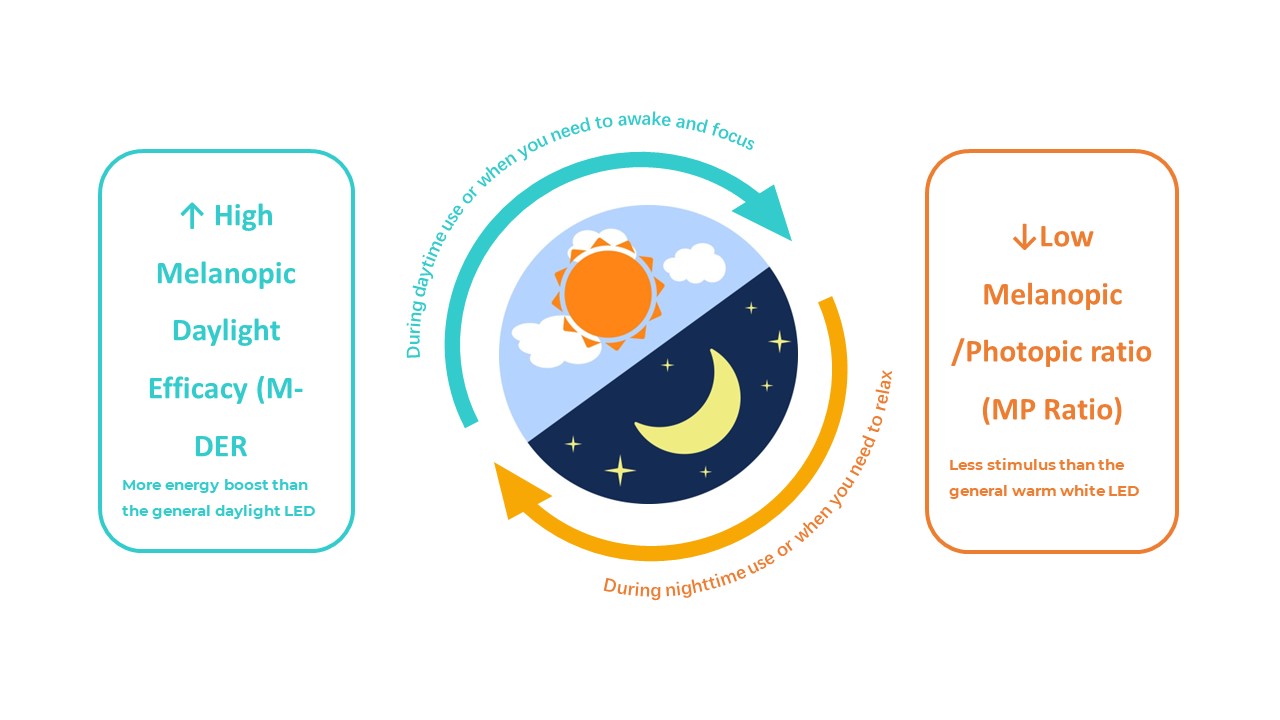
High CRI vs. High M/P Ratio, What’s the Difference?
In the ever-evolving landscape of lighting technology, two terms that often spark debates among lighting enthusiasts and professionals are High Color Rendering Index (CRI) and high Melanopic/Photopic Ratio (M/P Ratio). Understanding these concepts is crucial for creating lighting environments that not only look appealing but also contribute to overall well-being. Let's delve into the intricacies of CRI and M/P Ratio to shed light on their significance.
The M/P Ratio is a metric used to evaluate the impact of light on the melanopsin receptors in the human eye, which are responsible for non-visual responses like circadian rhythm regulation. It's a measure of the effectiveness of light in influencing these non-visual responses.
CRI, on the other hand, primarily assesses the color quality of light in terms of its ability to render colors accurately compared to natural light. It is scored on a scale of 0 to 100, with higher values indicating better color rendering. High CRI light sources are designed to mimic natural sunlight, ensuring that colors appear vivid and true to life.
1. High CRI: Seeing True Colors
Benefits of High CRI:
Accurate Color Representation: High CRI lighting ensures that objects appear as they would under natural sunlight, allowing for accurate color perception.
Enhanced Visual Comfort: Spaces illuminated with high-CRI lighting tend to be more visually comfortable, reducing eye strain and fatigue.
Improved Aesthetics: High-CRI lighting enhances the aesthetics of spaces by showcasing colors in their full vibrancy.
The primary objective of high CRI lighting is to faithfully represent colors, mimicking natural sunlight. This is especially crucial in environments where accurate color perception is essential, such as art galleries, retail spaces, or photography studios. High CRI lighting sources typically provide a broad spectrum of light, ensuring that colors appear vivid and true to life. Thus, it enhances the visual experience, allowing people to perceive colors in their truest form, with minimal distortion or color shifts.
2. Low M/P Ratio: Prioritizing Circadian Health
Low M/P Ratio lighting is designed to prioritize circadian health by minimizing the impact of blue light on the body's natural sleep-wake cycle. This is particularly important in settings where maintaining a healthy circadian rhythm is critical, like healthcare facilities, offices, and residential spaces.
Benefits of Low M/P Ratio:
Circadian Health Support: Low M/P Ratio lighting is designed to align with the body's natural circadian rhythm, promoting better sleep and overall well-being.
Reduced Blue Light Exposure: By minimizing the proportion of short-wavelength blue light, low M/P Ratio lighting helps mitigate the potential negative effects of blue light on sleep quality.
3. High M/P Ratio: Enhance Visual Perception
High M/P Ratio refers to a lighting source that emits a relatively higher proportion of short-wavelength (blue) light compared to the overall illuminance. The M/P Ratio is a metric that specifically considers the impact of light on the circadian system, influencing the body's natural sleep-wake cycle.
A higher M/P Ratio suggests a greater influence of light on circadian rhythm and, in practical terms, indicates a lighting environment that is more stimulating to the circadian system.
In general, we will use another concept to measure the awakening effect of this lamp. Just like we use the M/P ratio to go to choice the relaxed effect ones.
High Melanopic Daylight Efficacy Ratio:
Melanopic Daylight Efficacy Ratio (M-DER) is a metric for evaluating the circadian effect compared to the natural daylight (6500K), when M-DER = 1, the circadian effect of the light is equivalent to the daylight.
A high Melanopic Daylight Efficacy Ratio suggests that daylight is effective in influencing the circadian system. This can be important in architectural and lighting design to create environments that support human well-being and health.
Both concepts are linked to the spectral characteristics of light and their impact on human physiology, particularly the circadian system. A high M/P ratio or a high Melanopic Daylight Efficacy Ratio implies that the light source is more effective in influencing circadian rhythms.
Here are a few key points about high M-DER Ratio light:
Circadian Stimulation: High M-DER Ratio light is designed to provide a strong signal to the circadian system. This can be beneficial during the daytime when exposure to blue-rich light helps promote alertness, focus, and regulate the sleep-wake cycle.
Daytime Applications: Lighting sources with a high M-DER Ratio are often used in environments where promoting wakefulness and alertness is desired during daylight hours. This includes workplaces, schools, and other settings where maintaining a high level of attention and performance is important.
Impact on Sleep: Some lighting systems are designed to dynamically adjust the M/P Ratio based on the time of day. For example, the lighting might have a high M/P Ratio during the morning and afternoon to support alertness and productivity, and then transition to a lower M/P Ratio in the evening to promote a more relaxing and circadian-friendly environment.
The debate between High CRI and Low M/P Ratio is not about choosing one over the other; it's about understanding the specific needs of the environment and its occupants. A thoughtful combination of these lighting metrics can lead to spaces that are both visually stunning and supportive of human health and well-being. As technology continues to advance, the future of lighting design lies in creating solutions that seamlessly merge aesthetics with functionality, striking the perfect balance between form and function.

Leave a comment